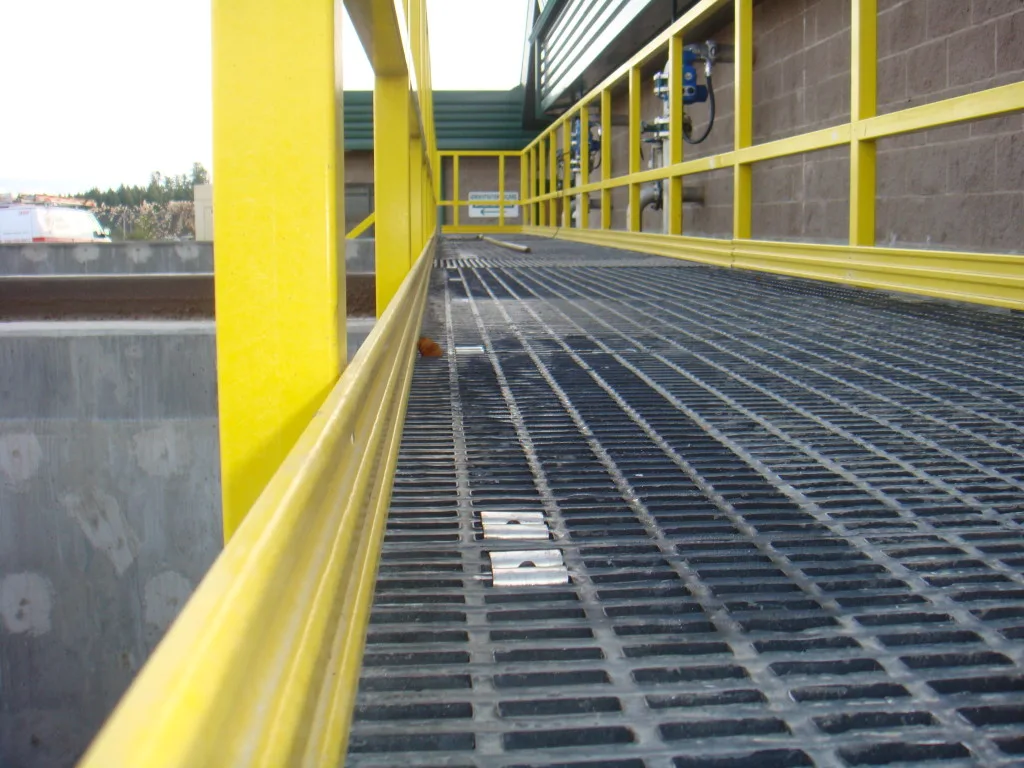Introduction
Fiberglass pultruded grating is becoming increasingly popular in various industries due to its durability, corrosion resistance, and lightweight properties. This versatile material is engineered through a process called pultrusion, which involves pulling glass fibers through a resin to create a strong and uniform product. In this article, we’ll explore the top 5 applications of fiberglass pultruded grating, showcasing its versatility and efficiency in different environments.

fiberglass pultruded grating
Fiberglass pultruded grating is a type of grating made by pulling continuous fiberglass rovings through a resin bath, then through a heated die to cure the resin. This process creates a strong, lightweight, and uniform product that offers many advantages over traditional materials like steel or aluminum.
Fiberglass pultruded grating stands out due to its durability and corrosion resistance, making it ideal for harsh environments. It is lightweight, which simplifies installation and reduces transportation costs. Additionally, it is non-conductive, providing safety benefits in electrical applications.
Application in Industrial Flooring
One of the most common uses of fiberglass pultruded grating is in industrial flooring. Its strength and durability make it perfect for heavy-duty environments. Industries such as oil and gas, manufacturing, and waste treatment plants benefit from its non-corrosive and non-slip properties, ensuring safe and reliable flooring solutions.
Specific Industrial Examples
- Oil and Gas: Used in platforms and walkways to prevent corrosion from chemicals and weather conditions.
- Manufacturing: Provides safe walkways and platforms that withstand heavy machinery.
- Waste Treatment: Offers a durable solution that resists corrosion from waste products.
Application in Walkways and Platforms
Fiberglass pultruded grating is also extensively used in walkways and platforms. Its non-slip surface enhances safety, while its lightweight nature makes it easy to install. Common settings include industrial plants, offshore platforms, and public walkways.
Safety Benefits
- Non-Slip Surface: Reduces the risk of accidents.
- Load Capacity: Supports heavy weights without deformation.
- Electrical Insulation: Safe to use around electrical equipment.
Application in Marine Environments
In marine environments, fiberglass grating excels due to its excellent resistance to saltwater corrosion. It is commonly used in docks, piers, and offshore platforms, where traditional materials would quickly degrade.
Examples in Marine Settings
- Docks and Piers: Provides durable, non-slip surfaces that withstand harsh marine conditions.
- Offshore Platforms: Ensures long-lasting, safe walkways for personnel.
Application in Chemical Plants
Fiberglass grating is ideal for chemical plants due to its resistance to a wide range of chemicals. It maintains its structural integrity and safety in environments where other materials would fail.
Specific Use Cases
- Chemical Storage Areas: Prevents corrosion and contamination.
- Processing Areas: Withstands spills and exposure to harsh chemicals.
Application in Food and Beverage Industry
In the food and beverage industry, fiberglass pultruded grating offers significant hygiene benefits. Its non-porous surface is easy to clean, making it suitable for food processing plants and areas requiring strict hygiene standards.
Hygiene Benefits
- Easy to Clean: Reduces the risk of bacterial growth.
- Non-Toxic: Safe for use in food-related environments.
Comparison with Traditional Materials
Fiberglass pultruded grating has several advantages over traditional materials like steel and aluminum. It is lighter, more corrosion-resistant, and requires less maintenance. These benefits make it a cost-effective and practical choice for many applications.
Installation and Maintenance
Installation of fiberglass grating is straightforward due to its lightweight nature. Long-term maintenance is minimal, mainly involving periodic cleaning and inspection to ensure safety and performance.
Maintenance Tips
- Regular Cleaning: Prevents build-up of debris and maintains non-slip properties.
- Periodic Inspections: Ensures structural integrity and safety.
Safety Considerations
When using fiberglass pultruded grating, several safety considerations should be kept in mind. Its non-slip surface, fire resistance, and load-bearing capacity make it a reliable choice for various environments.
Key Safety Features
- Non-Slip Surface: Reduces accident risks.
- Fire Resistance: Enhances safety in high-risk areas.
- Load Capacity: Supports heavy weights without compromising safety.
Cost-Effectiveness
While the initial investment in fiberglass pultruded grating might be higher than some traditional materials, the long-term savings are substantial. Its durability and low maintenance needs translate to lower overall costs over time.
Long-Term Savings
- Reduced Maintenance: Less frequent repairs and replacements.
- Longevity: Longer lifespan compared to traditional materials.
Customization Options
Fiberglass pultruded grating can be customized to meet specific needs. Options include different sizes, colors, and finishes, allowing for tailored solutions that fit unique requirements.
Tailoring Grating to Specific Needs
- Color Coding: For safety and organization.
- Size Variations: Custom sizes to fit any space.
Environmental Impact
Fiberglass grating has a positive environmental impact due to its longevity and recyclability. It requires fewer replacements, reducing waste, and can be recycled at the end of its life cycle.
Sustainability Benefits
- Recyclability: Can be recycled into new products.
- Reduced Waste: Long lifespan minimizes the need for replacements.
Future Trends in Fiberglass Grating
The future of fiberglass grating is promising, with ongoing innovations and new applications emerging. Advances in materials and manufacturing processes continue to expand its potential uses.
Upcoming Uses
- Renewable Energy: Applications in wind and solar energy infrastructure.
- Transportation: Use in lightweight, corrosion-resistant components for vehicles.
Conclusion
Fiberglass pultruded grating is a versatile and reliable material with numerous applications across various industries. Its durability, corrosion resistance, and safety features make it an excellent choice for environments that demand high performance and longevity. As industries continue to seek cost-effective and sustainable solutions, the use of fiberglass pultruded grating is likely to grow.
 info@unicomposite.com
info@unicomposite.com


























